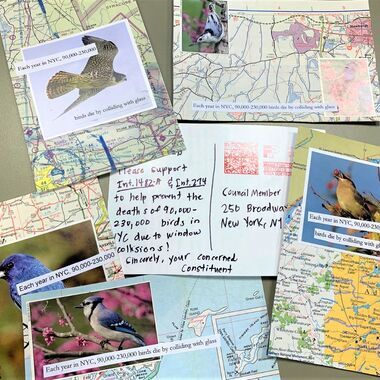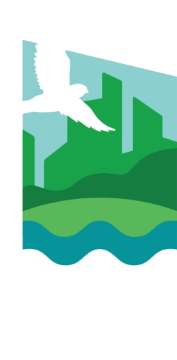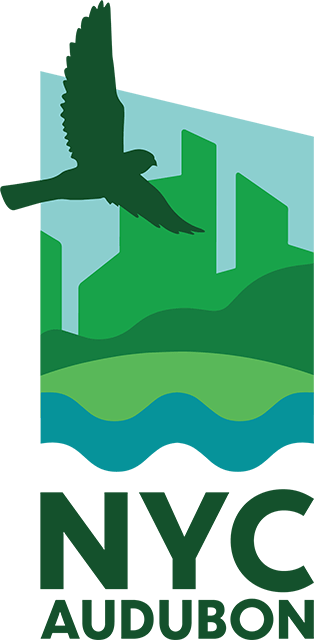Lights Out Legislation
Turning off artificial nighttime lighting helps protect night-migrating birds, keeping them on their natural migration paths. Photo: John Deguzman
Artificial light at night affects the millions of birds that pass through New York City during their migration. Birds rely on natural light cues for their migration, navigation, communication, and reproduction. Artificial light pollution can disrupt these behaviors, drawing them into the city and confusing them, making them more susceptible to collisions with windows and attacks by predators.
NYC Audubon is advocates for legislation that will reduce light at night during migration, to make the city more sustainable for birds and for people.
THE DARK SKIES PROTECTION ACT
Introduced in the NY State Senate by State Senator Brad Hoylman-Sigal (District 47) and the NY State Assembly by State Assemblymember Patricia Fahy (District 109), the Dark Skies Protection Act would add a new article to the environmental conservation law, which provides for the control of light pollution in New York State and establishes limits on the use of outdoor lighting. The Dark Skies Protection Act needs your support.
We are thankful that the Dark Skies Protection Act has been co-sponsored thus in the NY State Assembly by NY State Assemblymembers: Steck (District 110), Seawright (District 76), Simon (District 52), Burdick (District 93), Thiele (District 1) Jacobson (District 104), Glick (District 66), Paulin (District 88), Woerner (District 113), Gunther (District 100), Gallagher (District 50), Levenberg (District 95), and Kelles (District 125). And, in the NY State Senate by NY State Senators: Krueger (District 28), Myrie (District 20), and Palumbo (District 1).
TAKE ACTION FOR DARK SKIES
The Dark Skies Protection Act already has great momentum and could use your help! Here is what you can do to help get this bill over the finish line and help save the lives of wild birds:

Postcards sent by Avian Advocates in support of Int. 1482, the Bird-friendly Material Bill , in Fall 2019. Photo: NYC Audubon
CALL YOUR ELECTED OFFICIALS
Please call your New York State Senator and Assemblymember and urge them to sign on to the Dark Skies Protection Act [AB 5632-A (FAHY) / SB 7663 (HOYLMAN)] as co-sponsor (or thank them if they already have). You can use the following links if you're unsure of who your New York State Senator and Assemblymember are. If you need some ideas about what to say, here is a script you can use to navigate your call:
“Hello, [ELECTED OFFICIAL's NAME]! My name is [YOUR NAME], and I strongly support the Dark Skies Protection Act, the State-Level Lights Out Bill. I would like your support by co-sponsoring it and helping it pass.
Up to a quarter of a million birds are killed in collisions with glass annually in New York City alone. Artificial light at night attracts and disorients birds, confusing them and making them more susceptible to collisions both at night and during the day. Turning off the lights saves birds, reduces energy costs, and improves human health and mental well being.
[INSERT PERSONAL MESSAGE IF YOU HAVE ONE]
Please help us pass this bill, [ELECTED OFFICIAL’S NAME]. We are counting on your support.”
2023 PROPOSED CITY-LEVEL LEGISLATION
In May 2023, City Councilmember Francisco Moya introduced a bill requiring privately-owned commercial and industrial buildings in New York City to turn off non-essential lights during migration periods. The bill, Intro 1039, would prohibit nighttime illumination of the exterior or interior of privately-owned buildings during peak migration season, except where individuals remain inside and where nighttime illumination is required by law, rule or zoning resolution.
We are thankful that Intro 1039 has been co-sponsored thus by Councilmembers: Lincoln Restler (Brooklyn, District 33), Tiffany Cabán (Queens, District 22), Christopher Marte (Manhattan, District 1), Robert F. Holden (Queens, District 30), Gale A. Brewer (Manhattan, District 6), Shahana K. Hanif (Brooklyn, District 39), Erik D. Bottcher (Manhattan, District 3), Shekar Krishnan (Queens, District 25), Sandra Ung (Queens, District 20), and Julie Menin (Manhattan, District 5).
CALL YOUR COUNCIL MEMBER
Please call your New York City Council Member and urge them to sign on to Intro 1039 as co-sponsor (or thank them if they already have). You can use this widget if you're unsure of who your Council Member is. If you need some ideas about what to say, here is a script you can use to navigate your call:
“Hello, [COUNCIL MEMBER’S NAME]! My name is [YOUR NAME], and I strongly support the Intro 1039, the New York City Lights Out Bill. I would like your support by co-sponsoring it and helping it pass.
Up to a quarter of a million birds are killed in collisions with glass annually in New York City alone. Artificial light at night attracts and disorients birds, confusing them and making them more susceptible to collisions both at night and during the day. Turning off the lights saves birds, reduces energy costs, and improves human health and mental well being.
[INSERT PERSONAL MESSAGE IF YOU HAVE ONE]
Please help us pass this bill, [COUNCIL MEMBER’S NAME]. We are counting on your support.”
The Negative Impacts of Artificial Light on Migratory Birds
When point sources of artificial light, such as brightly lit skyscrapers and upward-facing beams, project into these birds' migratory airspace, this lighting may obscure the magnetic “guidelines” and/or disrupt the birds’ magnetic sense, causing them to deviate from their normal flight paths. Because of this phenomenon, New York City’s heavily-lit skies actually draws birds into our city when they otherwise wouldn’t travel through this area. And when birds travel through our city, they face a greatly increased risk of death or injury from collisions with New York City’s buildings.
The majority of collisions with buildings take place in the daylight, but the birds are drawn to these unsafe environments by night-time lights: the amount of light emitted by a building is a strong predictor of the number of collisions it will cause, more so than building height. When drawn into our city by building lights, birds may then be either injured as they flutter confusedly about the lights, or become exhausted and settle in inhospitable areas that make them more vulnerable to collisions. And when dawn comes and hungry birds look to refuel for their long journeys ahead, they encounter a confusing urban landscape full of glass windows and facades that reflect sky or habitat, often colliding as they seek refuge or escape.
_edited.jpg) "}" data-trix-content-type="undefined" class="attachment attachment--content">
"}" data-trix-content-type="undefined" class="attachment attachment--content">LIGHTS OUT ADVOCACY: PROTECTING BIRDS AND REDUCING LIGHT POLLUTION IN THE CITY THAT NEVER SLEEPS
Because of the connection between artificial lighting and collisions, many programs to protect migratory birds from collisions have focused on reducing night-time lighting during migration—including the Fatal Light Awareness Program (FLAP), the Toronto-based conservation society that spearheaded the lights-out movement in 1993, and NYC Audubon’s own Lights Out New York Program, founded in 2005.
Given New York City’s great size and huge number of artificially lit buildings, however, achieving an impactful level of consistent “lights out” participation by NYCs buildings has proved challenging.
NYC Audubon’s advocacy efforts focus on the creation, passage, and enforcement of legislation that would require a reduction in artificial night-time lighting during spring and fall migration. Such laws would save the lives of countless birds—and in reducing energy consumption, form a logical part of the City’s sustainability strategy.
2021 Lights Out Victory: City-Owned Buildings
Working alongside the Lights Out Coalition, we achieved a significant policy victory with the unanimous passage in the New York City Council of artificial light legislation in December 2021. This legislation requires that all city-owned buildings turn their nonessential outdoor lights off from 11pm to 6am during spring and fall migration periods.
Read more about the passage of this landmark legislation on our blog.


